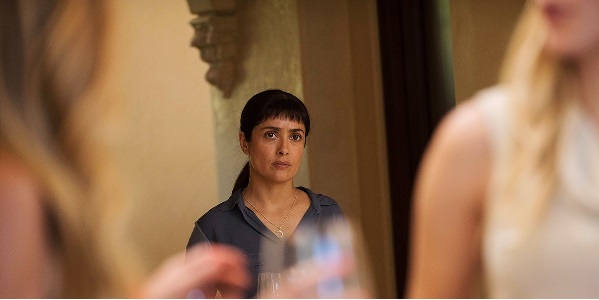BEATRIZ AT DINNER: At The Table With The Devil

Hazem Fahmy is a poet and critic from Cairo. He…
Masquerading as a dinner comedy, Beatriz at Dinner, Miguel Arteta’s triumphant return to indie filmmaking, is an immaculately uncomfortable cinematic experience in the best way. It is perhaps the most pitch perfect synthesis of white male micro-aggression I have ever seen in film, one that proves exceptionally vital in America’s current political climate.
Once the action starts, every scene acts as a chilling reminder of the toxicity of white supremacy; the way it can manifest in the simplest glances or words. We see all this through the eyes of the titular Beatriz (seamlessly brought to life by Salma Hayek) who, at first, comes across as a somewhat one-dimensional trope, but by the end emerges as one of the most fascinating characters I’ve yet to see in cinema this year.
Arteta essentially plays a fine, and fascinating trick with his audience. When we first meet Beatriz, we are bombarded with visual information about her spirituality and down-to-earth attitude. Beatriz at Dinner begins in her humble bedroom as she is woken up by her goat who, as we learn later, she lovingly relocated from her garden to her humble Los Angeles home due to the harassment of her neighbor.

Through the décor of her car, we see that she practices both Catholicism and Buddhism. Her first destination is a cancer treatment center in which she volunteers to aid patients undergoing chemotherapy through both spiritual and physical exercises. It is only after Beatriz at Dinner establishes Beatriz as a ray of sunshine does she finally drive over to the mansion of her wealthy massage clients where the rest of the story takes place.
White Haven
From the get go, Arteta establishes a classic dynamic. Beatriz’s white, wealthy and obnoxious client Cathy, whose daughter Beatriz had helped through chemotherapy a few years earlier, acts as though she is oblivious to the power dynamic between her and Beatriz. From the way she casually rambles during their session, we can see that Cathy thinks Beatriz is her ‘friend’, even though the conversation, in terms of both topics and length, is clearly skewed towards Cathy.
When Beatriz’s car breaks down, Cathy immediately resolves that she must stay over for dinner, an incessant request to which Beatriz eventually succumbs. To Beatriz’s misfortune, said dinner happens to be a celebration of the family’s business partners, the most important of which is John Lithgow’s horrifying Doug Strutt.
Strutt is a Trumpian figure in everything but orange complexion. He is bloated with arrogance, talks openly and cheerfully about the exploitative lengths he went through to secure his business interests, and reflects fondly on the time he illegally shot an endangered rhino on a safari. Moreover, his first interaction with Beatriz is itself a racial micro-aggression. He takes one look at her and immediately assumes that she is part of the help. “Can I get another bourbon, hun?” are his first words to her. It by no means gets better from there. Later at dinner, when Beatriz is recounting how she got to the States from Mexico, he abruptly interjects to ask her if she came legally.

The fierce tension between Beatriz and Doug is only fuelled by the slick revelation that Beatriz left her hometown because of the devastating effects of a construction project that sounds eerily similar to ones Doug has boasted about owning in Mexico. It is here that Arteta creates an obvious, but nonetheless vital, metaphor for the bitter irony that is, for many, immigration to America. Beatriz was forced to leave her home because of the exploitation of powerful white American men and here she sits, face-to-face with one of them, being asked by her ‘friend’ Cathy to not only tolerate his racism, but also celebrate his business ingenuity. It is a cruel night that Beatriz must endure.
As Doug goes on and on about himself and his exploits, Beatriz finally begins to let go of respectability in favor of speaking out. For the audience, her outbursts come across as well-earned moments of catharsis, but for the rest of Cathy’s all-white party, they seem irrational and unwarranted; a typical, dismissive response countless people of color, and especially women, face when expressing their rage to white people.
It is in that conflict that Arteta’s trick begins to reveal itself. The more Beatriz and Doug come into friction, the more the film reveals that Beatriz simply has a fundamentally different outlook on the world than these people. Though Doug is positioned as the head of the snake, all the other guests, and Cathy herself, are completely complicit in his atrociousness, whether it simply be through working with him or through validating his perspective.
An Ideal Thorn
Arteta takes a big risk in his characterization of Beatriz, especially in opposition to the guests at the party. We’ve already seen from the start how she checks all the boxes of a modern day saint, but the emphasis on her ‘goodness’ is only monumentally heightened in Beatriz’s interactions with Cathy’s guests. Everything from their cars and their clothing and choice of drink tells us that they are pretentious, hyper-materialistic and overall just shallow.
The only prospective issue with this contrast is that it risks essentializing Beatriz, as an immigrant Latina woman, as some sort of ‘pure’ figure in opposition to the capitalistic white people. For much of Beatriz at Dinner, it seems as though Arteta is borderline idealizing Beatriz, a depiction that could have robbed her of complexity and personality.

But Arteta complicates his own characterization of Beatriz in the third act. Without venturing into spoilers, we see that her idealism, though ultimately a far better and more compassionate look on the world than that of the white guests, inevitably takes a monumental toll on her personhood. Towards the end of the film, Beatriz finds herself face-to-face with a tremendous decision, one that her values stop her from taking. We are left questioning whether or not it was worth it, though it seems like it absolutely should have been.
Verdict
It’s rare that a film will come along and synthesize the era we live in so succinctly. I ached watching this film, reminded as a first generation American of color myself of the seeming impossibility of defeating white supremacy. There’s no doubt we need Arteta back on the indie side of the industry.
What did you think of Beatriz at Dinner‘s ending?
Beatriz at Dinner was released on 9 June in the US. For a list of full release dates, see here.
Does content like this matter to you?
Become a Member and support film journalism. Unlock access to all of Film Inquiry`s great articles. Join a community of like-minded readers who are passionate about cinema - get access to our private members Network, give back to independent filmmakers, and more.
Hazem Fahmy is a poet and critic from Cairo. He is an Honors graduate of Wesleyan University’s College of Letters where he studied literature, philosophy, history and film. His work has appeared, or is forthcoming in Apogee, HEArt, Mizna, and The Offing. In his spare time, Hazem writes about the Middle East and tries to come up with creative ways to mock Classicism. He makes videos occasionally.













